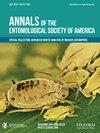How mixture of plant and prey diets affects long-term rearing of predatory mite Neoseiulus cucumeris (Acari: Phytoseiidae)
IF 1.8
3区 农林科学
Q1 ENTOMOLOGY
引用次数: 1
Abstract
The phytoseiid mite Neoseiulus cucumeris (Oudemans) (Acari: Phytoseiidae) is one of the well-known natural enemies across the globe which can feed on different types of pests and pollen grains. This predator was reared on the mixture of the stored products mite, Tyrophagus putrescentiae (Schrank) (Acari: Acaridae) (as prey diet) along with different plant pollens (as plant diet) including almond (TA), cattail (TC), castor-bean (TCb), date (TD), saffron (TS), and mixed pollens of almond, cattail, castor bean, and date (TP) for 20 generations (G1–G20). The effects of the mixed plant and prey diets on biological parameters of N. cucumeris were evaluated under laboratory conditions at 25 ± 1°C, 60 ± 5% RH, and a photoperiod of 16:8 (L: D) h every 10 generations (G1, G10, and G20). N. cucumeris showed the highest performance on the mixed pollens + T. putrescentiae (TP diet) among the diets tested. Our findings revealed almost stable performance of the predator by long-term feeding on a mixture of pollen and prey diet and this combination can use as a suitable alternative food for mass rearing of N. cucumeris. Graphical Abstract植物和猎物混合饮食对黄瓜新小绥螨长期饲养的影响
植物寄生螨Neoseulus cucumeris(Oudemans)(Acari:植物寄生科)是全球著名的天敌之一,可以捕食不同类型的害虫和花粉粒。这种捕食者是在储存的产品螨、腐败的Tyrophagus putescentiae(Schrank)(Acari:Acadidae)(作为猎物日粮)以及不同的植物花粉(作为植物日粮)(包括杏仁(TA)、香蒲(TC)、蓖麻豆(TCb)、椰枣(TD)、藏红花(TS)和杏仁、香蒲、蓖麻豆和椰枣(TP)的混合花粉的混合物中饲养20代(G1–G20)。在实验室条件下,在25±1°C、60±5%相对湿度和每10代(G1、G10和G20)16:8(L:D)h的光周期下,评估了植物和猎物混合日粮对库库默猪笼草生物学参数的影响。在所测试的日粮中,N.cucumeris在混合花粉+腐霉(TP日粮)上表现出最高的表现。我们的研究结果表明,通过长期食用花粉和猎物的混合物,捕食者的表现几乎稳定,这种组合可以作为大规模饲养库库默猪笼草的合适替代食物。图形摘要
本文章由计算机程序翻译,如有差异,请以英文原文为准。
求助全文
约1分钟内获得全文
求助全文
来源期刊
CiteScore
4.90
自引率
0.00%
发文量
25
审稿时长
6-12 weeks
期刊介绍:
The Annals of the Entomological Society of America exists to stimulate interdisciplinary dialogue across the entomological disciplines and to advance cooperative interaction among diverse groups of entomologists. It seeks to attract and publish cutting-edge research, reviews, collections of articles on a common topic of broad interest, and discussion of topics with national or international importance. We especially welcome articles covering developing areas of research, controversial issues or debate, and topics of importance to society. Manuscripts that are primarily reports of new species, methodology, pest management, or the biology of single species generally will be referred to other journals of the ESA. The most important criteria for acceptance are quality of work and breadth of interest to the readership.

 求助内容:
求助内容: 应助结果提醒方式:
应助结果提醒方式:


